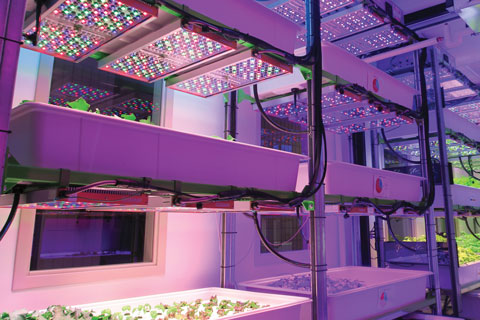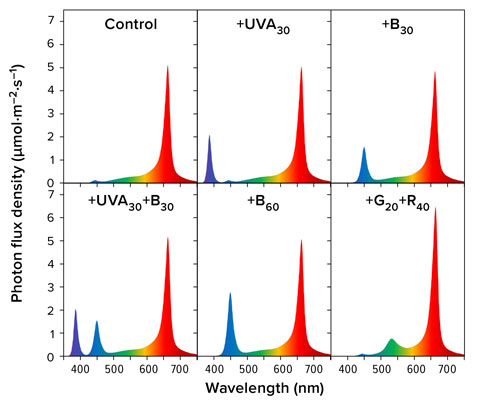2/1/2024
Improving Lettuce Nutrition & Coloration With Lighting
Nathan Kelly & Erik S. Runkle

Fresh leafy greens, such as lettuce and kale, are in high demand year-round because they’re usually the base ingredient for healthy and nutritious salads. Indoor vertical farming enables the local production of high-quality lettuce that’s readily available to consumers. Controlled environment agriculture practices and technology enable growers to manipulate environmental parameters such as temperature, carbon dioxide (CO2) concentration, and light intensity, spectrum and duration to fine-tune production for specific crop attributes. One challenge indoor growers can face with red-leaf lettuce is a lack of the desirable deep red coloration. However, a light spectrum or temperature that promotes red-leaf coloration may come with a sacrifice of less harvestable yield. Therefore, there are often trade-offs to consider when attempting to optimize yield and quality attributes.
Figure 1. The Controlled-Environment Lighting Laboratory (CELL) at Michigan State University. The growth room consists of hydroponic growing racks with customizable light-emitting diodes (LEDs).
Previous research has shown that light intensity, and blue light (400 to 500 nm) specifically, can regulate red-leaf lettuce leaf coloration by controlling the synthesis of different color-causing pigments such as anthocyanins. For example, article one of this series (November 2023) summarized research that investigated the effects of end-of-production (EOP) lighting to improve red-leaf lettuce coloration. Light intensity at the EOP had a greater effect on red-leaf pigmentation and anthocyanin concentration than the blue light percentage delivered at a lower light intensity.
In addition to anthocyanins, phenolic compounds are another group of nutritious molecules that can be influenced by the light environment. UVA (315 to 400 nm) and blue light specifically increase phenolic compound synthesis along with anthocyanins. However, few studies have compared the efficacy of these two wavebands at equal light intensities. Therefore, our objective was to evaluate the relative efficacy of a light spectrum enriched with UVA light, blue light or both at EOP at increasing red-leaf lettuce coloration and nutrient concentrations while also considering yield.
Study design
Red-leaf lettuce Rouxai was selected for this study because of its commercial relevance and sensitivity to the light spectrum. Lettuce seeds were sown in 200-cell rockwool sheets and germinated at ambient CO2, a temperature of 74F (23C) and under 180 µmol∙m–2∙s–1 of warm-white light provided by light-emitting diodes (LEDs) for 24 hours per day in the Controlled-Environment Lighting Laboratory (Figure 1). Three days after seed sow, the photoperiod was shortened to 20 hours and the light spectrum was changed to a base spectrum of 100 µmol∙m−2∙s−1 of warm-white light plus 80 µmol∙m−2∙s−1 of red light (a daily light integral of 13.0 mol∙m−2∙d−1).
On Day 10, the lettuce seedlings were transplanted into a deep-flow hydroponics system with a recirculating nutrient solution (150 ppm N) and the same environmental conditions. On Day 24, EOP light treatments were added to the base spectrum for the last six days of production. EOP light treatments consisted of the control (no additional light) or an additional 30 or 60 µmol∙m−2∙s−1 of blue light, 30 µmol∙m−2∙s−1 of UVA light, 30 µmol∙m−2∙s−1 of blue plus 30 µmol∙m−2∙s−1 of UVA light or 20 µmol∙m−2∙s−1 of green plus 40 µmol∙m−2∙s−1 of red light (Figure 2). The EOP light treatments were applied for the entire 20-hour photoperiod and increased the DLI from 13.0 mol∙m−2∙d−1 to 15.1 or 17.3 mol∙m−2∙d−1 during the final six days of production.
On Day 30, 10 random plants from each treatment were harvested for data collection, while three plants were harvested for total phenolic and anthocyanin concentration analysis, as well as leaf coloration analysis. Leaf coloration measurements are the average coloration of the entire plant. The experiment was performed twice in time to control for experimental error.
Our findings
After six days of EOP treatments, we harvested lettuce Rouxai and made various growth measurements. Despite the higher light intensity during the EOP treatments, lettuce had statistically similar fresh mass (yield) as plants grown without supplemental EOP lighting (Figure 3). However, lettuce grown under EOP treatments that provided an additional 60 µmol∙m−2∙s−1 of light had more dry mass than plants grown without supplemental EOP light.
 Figure 2. Light spectra of various end-of-production light treatments. Treatments consisted of additional ultraviolet-A (UVA), blue (B) or green (G) plus red (R) light. Subscripts indicate the supplemental photon flux density of each waveband.
Figure 2. Light spectra of various end-of-production light treatments. Treatments consisted of additional ultraviolet-A (UVA), blue (B) or green (G) plus red (R) light. Subscripts indicate the supplemental photon flux density of each waveband.
Additionally, we measured the total phenolic and anthocyanin concentrations of lettuce grown under the various EOP light treatments. Total phenolic concentration doubled when 30 or 60 µmol∙m−2∙s−1 of UVA or blue light was applied. Furthermore, increasing the light intensity at the EOP with green plus red light led to similar phenolic concentrations as lettuce grown under elevated UVA or blue EOP light. Total anthocyanin concentrations followed similar trends to phenolic compounds except the green plus red light didn’t increase concentrations. Finally, an additional 30 or 60 µmol∙m−2∙s−1 of UVA or blue light similarly increased total phenolic and anthocyanin concentrations. This indicates that UVA and blue light were similarly effective at increasing lettuce nutritional quality and leaf redness.
Although an increase in anthocyanin concentration led to an increase in leaf redness (a*), only the higher light intensity of blue or blue plus UVA light increased leaf redness compared to lettuce grown without EOP light (Figure 3). In other words, more than 30 µmol∙m−2∙s−1 of additional UVA or blue light was needed to noticeably increase the coloration of Rouxai.
Key takeaways
Applying supplemental UVA or blue light for the final six days of production was an effective method to increase red-leaf lettuce Rouxai redness and nutritional quality without inhibiting biomass accumulation. When applied as EOP light, UVA and blue light were similarly effective at improving lettuce quality. Considering blue LEDs are less expensive, more energy efficient and less harmful to human eyes and skin than UV LEDs, supplementing the light spectrum with blue light at the EOP is the more practical option. In the next article, we’ll compare the effects of EOP lighting to the continuous application of blue or UVA light.

About This Series The four-part End of Production series from Michigan State University’s Optimizing Indoor Agriculture (OptimIA) research started in November 2023 and will conclude in the fall issue of 2024. Here’s a rundown on the series in Inside Grower:
November 2023: “Influencing Red Leaf Lettuce”
Spring 2024: “Improving Lettuce Nutrition & Coloration with Lighting”
Summer 2024: Continuous versus end-of-production supplemental light (coming in May 2024)
Fall 2024: End-of-production temperature reduction impact on lettuce leaf coloration (coming in August 2024)
Nathan Kelly recently completed his Ph.D. in Horticulture at Michigan State University (MSU) and Erik Runkle is a Professor and Extension Specialist in the Department of Horticulture at MSU. This research was supported by the Specialty Crops Research Initiative (grant no. 2019-51181-30017) and Hatch project 192266 from the United States Department of Agriculture National Institute of Food and Agriculture. For more information on this project, visit scri-optimia.org. The authors thank Ryan Warner, Viktorija Vaštakaitė-Kairienė and Mckenna Merkel for experimental assistance.